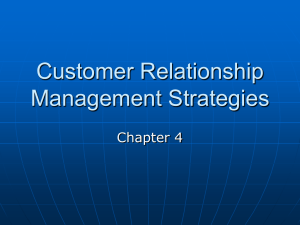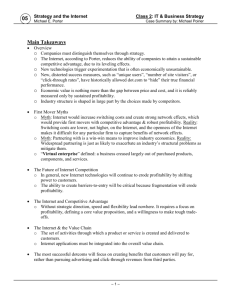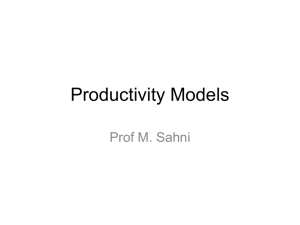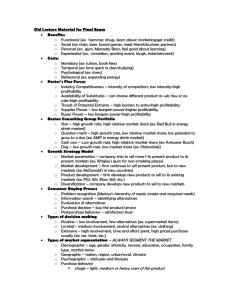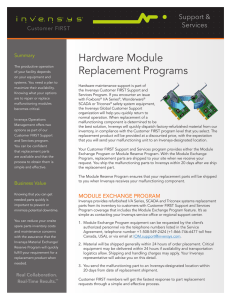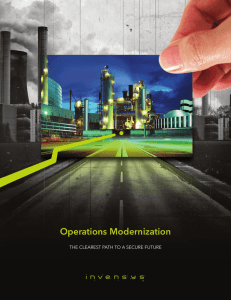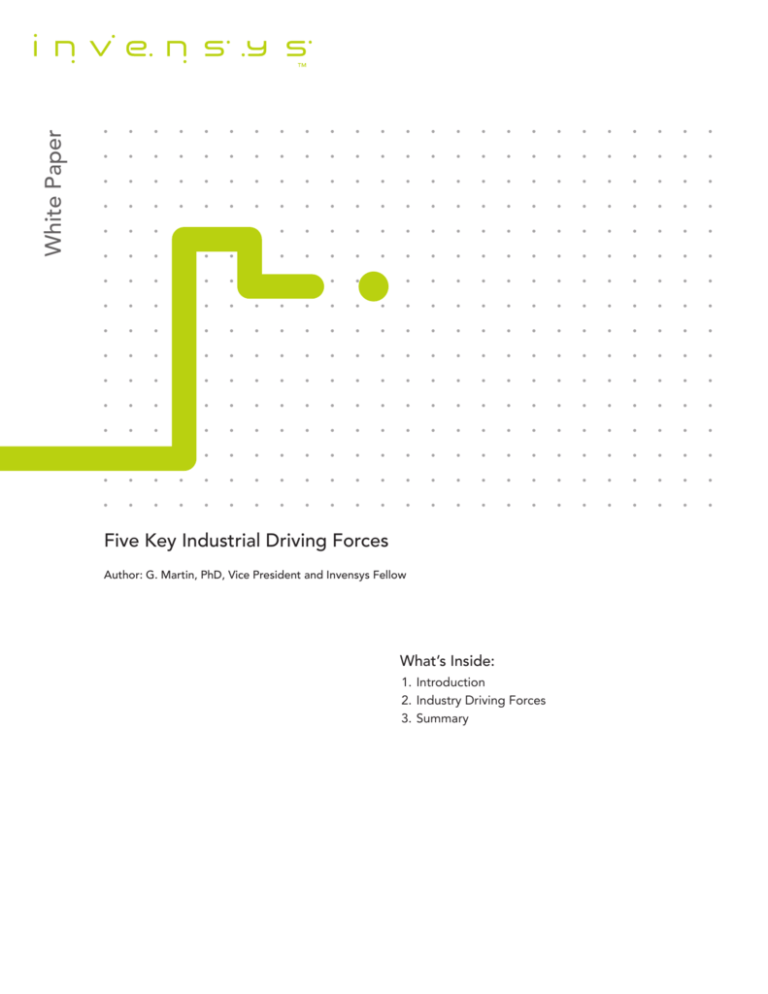
White Paper
Five Key Industrial Driving Forces
Author: G. Martin, PhD, Vice President and Invensys Fellow
What’s Inside:
1.Introduction
2.Industry Driving Forces
3.Summary
Five Key Industrial Driving Forces
1. Introduction
Today, it is imperative for automation and information systems, software suppliers, leaders of manufacturing, and production
companies to understand the key market and technology forces working to drive significant changes in the industrial market space.
Manufacturing and production companies must be aware of these forces and prepare strategies and execution plans to effectively
deal with them as they impact industrial operations. Suppliers must also be aware of these forces to provide manufacturing and
production companies with effective solutions.
Since the dawn of the industrial revolution, there may not have been a period of such market and technological volatility in the
industrial space as there is today. Huge transitions, many driven by globalization, in operational characteristics are beginning to impact
industrial companies in ways never previously experienced. The ongoing survival for industrial companies may be predicated on how
they rise to the challenges presented by these driving forces. But this cannot be completed until the key driving forces impacting the
industry are clearly identified and strategies for effective reaction are initiated.
2. Industry Driving Forces
The Invensys Fellows were recently assigned the task to review current research, work with customers and analyze market trends to
identify the driving forces most likely to cause disruptions to industrial businesses over the next five to ten years and craft a vision
statement for how industrial operations can rise to meet the challenges imposed by these forces. After considerable research,
discussion and debate, the Fellows identified the following five key driving forces most likely to impact industrial businesses.
The five identified driving forces are:
1. The transition from labor workers to performance managers - since the industrial revolution, industrial companies have tended
to view the frontline personnel as laborers rather than as skilled craftsmen and have worked to reduce and eliminate as many of
these laborers as possible. Today, many frontline personnel are very experienced and very well educated as compared with their
predecessors. Furthermore, after decades of downsizing, the frontline staff is typically below critical mass for the operation of the
plant. This combination is leading industrial managers to try and obtain more value from this critical resource base, rather than
eliminating them. This value can be realized when these talented people are empowered to not only operate the plant, but also
help manage the business performance of the plant. The empowerment, although starting at the frontline, must impact all levels
of industrial operations by providing the decision support information to each person in the operation responsible for any aspect
of business and operational performance. Providing the right information contextualized to each individual’s area of responsibility
at the right time is critical to the business success of any industrial operation. This transition has begun in some progressive
companies, but will become a serious trend over the next few years.
2. The transition from transactional to a real-time business environment – since the inception of the industrial revolution, the
primary business variables of industrial operations have been reported and managed on a monthly basis. Monthly business
management was adequate because the business variables did not change very often. For example, only a few years ago
most industrial companies were able to develop contracts with their energy suppliers that covered a period of six months to a
year. These contracts essentially relegated to price they paid for the energy they consumed to a constant value over that time
period. If a value is not changing there is no need to control it. Over the past few years, initially triggered by the deregulation
of the power grid throughout the world, this situation has started to drastically change. Business variables that had been
constants over extended time periods, such as production value, energy costs and material costs, are starting to experience
considerable variability, some changing many times within a single day. This means that the business environment of the industry
is transitioning to a real-time environment and the systems currently in place are not geared to deal with this shift.
Page 1
Five Key Industrial Driving Forces
3. The transition from process to product management – traditionally, many manufacturing operations have been set up to
accomplish their missions of producing products in the most profitable manner by automating each process in the plant,
somewhat independently, and counting on the efficiency and effectiveness of each process control scheme to result in an
efficient and effective plant business operation. The drive to optimal efficiency has been the primary focus of industrial
operations for decades. Optimal efficiency has traditionally translated directly into optimal profitability, but this does not appear
to be the case at many industrial operations primarily due to the higher levels of volatility in the business variables of industrial
operations. Although driving efficiency improvements has been very successful for years, as the profitability of many industrial
operations are being squeezed, managers are striving for higher levels of profitability through higher levels of control. The
objective of any industrial operation is to not only have processes under control; rather it is to produce products profitably.
This will lead to a refocusing of control from controlling processes to a higher level of control focused on both processes and
products for profitability. Industrial firms are in the business of driving profits and stronger profit-oriented perspectives are
continuing to emerge.
4. The transition from an island to a holistic business perspective – as industrial operations, technologies and organizations
became more and more complex during the industrial revolution, the people leading these enterprises found that the only
effective way to deal with the complexity was to partition the operations into areas of specialty. Each specialty area would work
to an acceptable level, and then try to coordinate across them. This led to the development of islands of automation, islands
of information and islands of organization. Each island may have adequately performed its task, but the coordination and
collaboration between the islands became a nightmare. Specialists dedicated to one island could not understand the technology
or even vernacular of other islands. If they cannot effectively talk together, how can they solve problems together? This is
becoming a very large and daunting challenge to industrial companies and must be met over the next decade.
5. The transition from rigid to agile operations – many industrial operations were designed and built in an era in which more was
better. Plants were designed to produce as much of their output as possible over any time frame. The market was such that
it could absorb whatever was produced. The marketplace has changed for many industrial concerns and profitability can only
be maximized by producing the right volumes of products over a rapidly fluctuating demand base. For example, in the power
industry as the grids opened up it produced a highly competitive production environment. Success is defined by placing the
right level of power onto the grid at the highest profit points on the grid. Running plants at full production no longer results in
increased profit. However, most power plants were literally designed to be optimized at full production. This has cause power
companies to build small peaking power plants that kick in as demand and profitability dictate. Unfortunately, these peaking
plants tend to be much more expensive to operate per unit output than traditional plants. It is not only the power industry that
is facing this dilemma, the challenge is getting a rigidly designed plant or set of plants, that have been designed around full
production objectives to become more agile.
3. Summary
There are certainly many additional forces that will impact the industrial marketplace over the next five to ten years, but the five
identified herein may have the most direct impact on the way industrial operations must execute to succeed. There are three areas of
response that every industrial concern must consider as these forces start to impact the operation and business of plants.
• Enabling collaborative and empowered operations
• Operating the business of industry in real time
• Focusing on maximizing enterprise operational profitability
Enabling collaborative and empowered cultures helps industrial companies to meet the need of moving their frontline, and all
operating personnel from laborers to performance managers. Operating industrial businesses in real time helps to meet the needs
driven by the transition from transactional to real-time business environments. Maximizing enterprise operational profitability
addresses both the transition from process to product management and from rigid to agile operation. The first and third areas are
required to transition an enterprise from an island to a holistic perspective.
Page 2
Five Key Industrial Driving Forces
Figure 1
A simple real-time business model (Figure 1) for industrial companies is useful to identify the key aspects of a holistic industrial business
perspective. The three vectors at the center of the model represent a real-time profitability view of a plant or enterprise. The primary
reason any industrial plant exists, in a profit-driven company, is to produce economic value for the company by producing profitgenerating products. Therefore, the primary objective is maximizing the production value vector and must be completed while reducing
the variable cost of operation of the plant. The main components of variable cost that have a real-time impact are energy and material
costs. Although labor and other costs have an impact on profitability, they can typically be managed on a transactional basis since they
do not tend to vary in real time. The combination of maximizing production value while minimizing the real-time components of variable
cost provides a real-time profitability model for a plant. Unfortunately, as with most objectives, these three vectors are constrained. The
two primary constraint functions that have real-time variability are safety and environmental stewardship. Therefore, as the driving forces
start to have an impact on industrial operations, industrial organizations will need to control the business variables of their operations in
real time by balancing the real-time business model for each plant and the enterprise as a whole.
The industry is in for very challenging times as the five driving forces impact operations in ways never previously experienced. The companies that best survive and thrive will be those that deal with the impact of the driving forces in the most effective manner. This will require a
holistic, real-time business model that will help drive profitability and agility across industrial plants and entire industrial enterprises.
Invensys Operations Management • 5601 Granite Parkway III, #1000, Plano, TX 75024 • Tel: (469) 365-6400 • Fax: (469) 365-6401 • iom.invensys.com
Invensys, the Invensys logo, ArchestrA, Avantis, Eurotherm, Foxboro, IMServ, InFusion, SimSci-Esscor, Skelta, Triconex, and Wonderware are trademarks of Invensys plc, its subsidiaries or affiliates.
All other brands and product names may be the trademarks or service marks of their representative owners.
© 2010 Invensys Systems, Inc. All rights reserved. No part of the material protected by this copyright may be reproduced or utilized in any form or by any means, electronic or mechanical, including
photocopying, recording, broadcasting, or by any information storage and retrieval system, without permission in writing from Invensys Systems, Inc.
Rel. 09/10
PN IN-0134
Page 3



